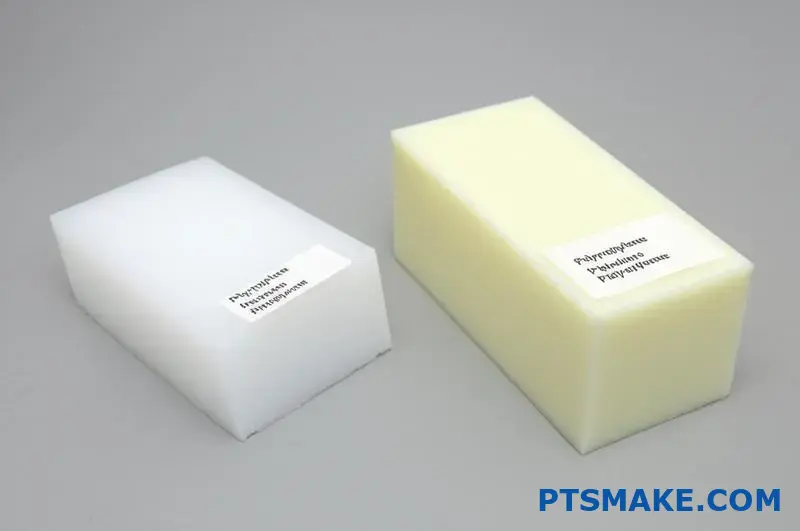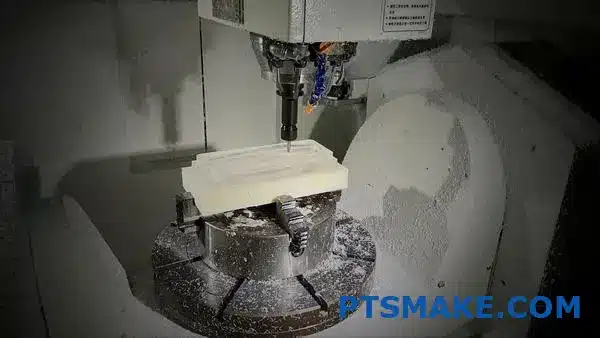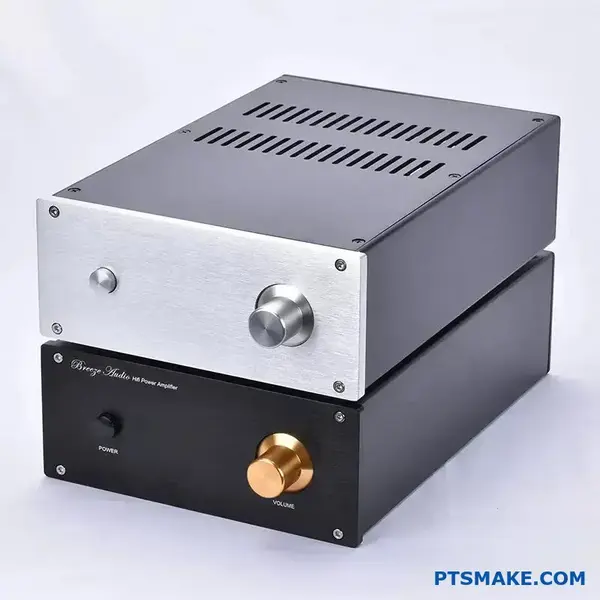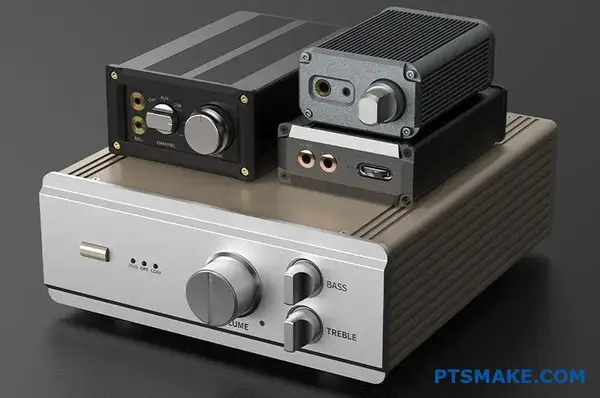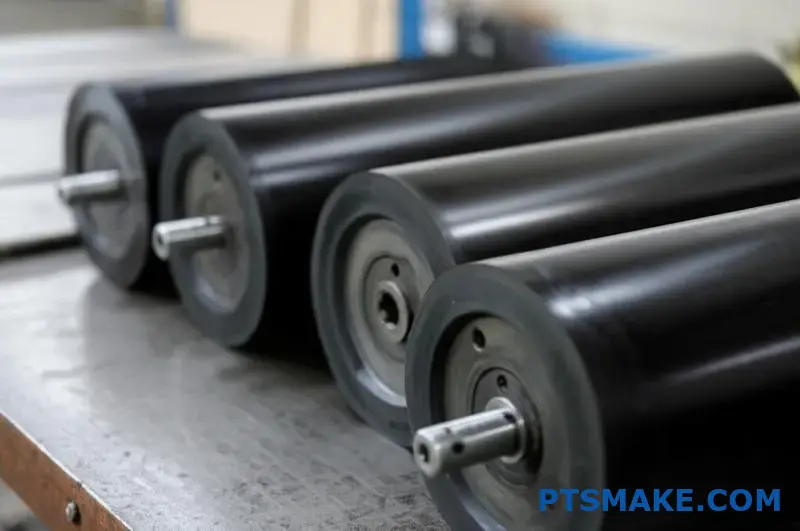Benefits of Upgrading to Custom Control Arms
Ever wondered why professional racers and serious off-road enthusiasts invest so heavily in their suspension systems? The secret often lies in one critical component that many overlook: custom control arms that transform ordinary vehicles into precision machines.
Custom control arms represent one of the most impactful suspension upgrades available, delivering dramatic improvements in handling, durability, and overall vehicle performance that factory components simply cannot match.

The Function of Control Arms in Your Vehicle
Control arms are pivotal suspension components that connect your vehicle’s frame to the steering knuckles and wheel hubs. They allow for controlled vertical movement of the wheels while maintaining proper alignment during travel. Factory control arms are designed with cost-efficiency and average driving conditions in mind, creating a compromise between comfort, performance, and longevity.
In my experience working with performance vehicles at PTSMAKE, I’ve seen how these stock components often become a limiting factor for drivers seeking enhanced capability. The restrictions of factory arms become especially apparent when:
- Increasing wheel size or changing offset
- Adding lift kits or lowering the vehicle
- Engaging in off-road adventures or track days
- Carrying heavy loads regularly
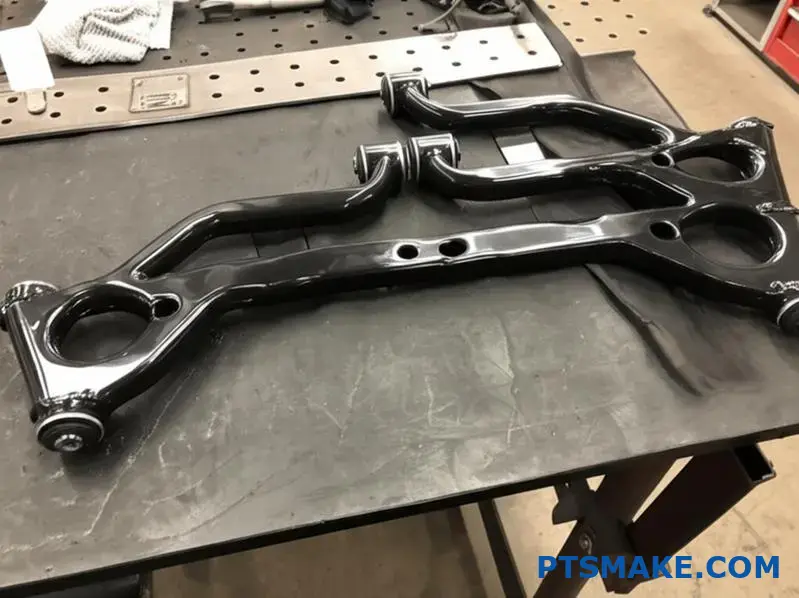
Enhanced Wheel Travel and Articulation
One of the most significant advantages of upgrading to custom control arms is the improved wheel travel they provide. Factory arms typically restrict suspension movement to protect other components and maintain everyday drivability. Custom arms are engineered to allow for greater articulation while maintaining proper geometry throughout the suspension’s range of motion.
For off-road enthusiasts, this means:
- Better obstacle clearance
- Improved traction on uneven terrain
- Reduced risk of high-centering
- More predictable handling in extreme conditions
For street performance, enhanced wheel travel translates to:
- Better weight transfer during cornering
- Improved grip under acceleration
- More consistent contact patch during braking
- Reduced impact harshness over road imperfections
The ability to fine-tune your suspension’s kinematics1 through custom control arms allows for optimization specific to your driving style and vehicle usage.
Superior Durability and Material Construction
Factory control arms are typically constructed from stamped steel or cast aluminum, materials chosen primarily for cost-effectiveness and adequate performance in normal driving conditions. Custom control arms elevate durability through:
Advanced Materials
Custom arms often utilize:
- High-grade tubular steel
- Billet aluminum
- Chromoly steel alloys
- Carbon fiber (in high-end racing applications)
Reinforced Design
The structural integrity is enhanced with:
- Gusseted joints
- Increased material thickness
- Computer-optimized stress distribution
- Reduced flex under load
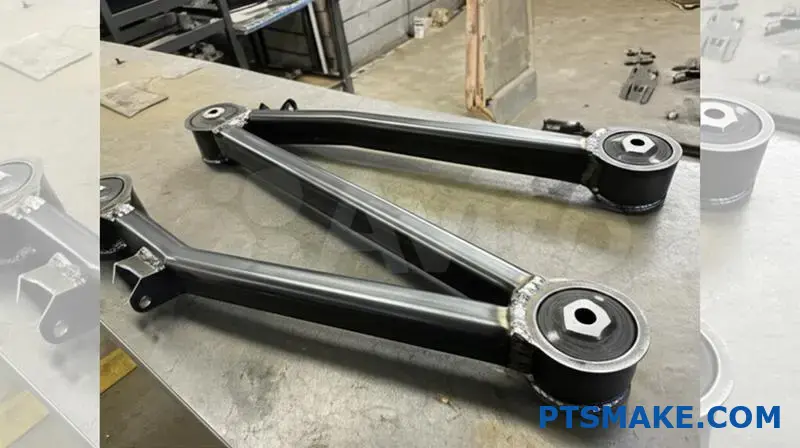
Superior Bushings and Joints
The connection points on custom control arms represent another major upgrade over factory components:
| Feature | Factory Arms | Custom Arms |
|---|---|---|
| Bushings | Rubber | Polyurethane, Delrin, or metal |
| Joints | Basic ball joints | Heavy-duty ball joints or rod ends |
| Adjustability | None | Often fully adjustable |
| Noise/Vibration | More dampening | Performance-focused (may transfer more road feel) |
| Lifespan | 50,000-100,000 miles | 2-3× longer with proper maintenance |
These upgraded connection points dramatically reduce deflection under load, providing more precise control and feedback while extending service intervals.
Handling Benefits and Performance Gains
The impact of custom control arms on vehicle handling cannot be overstated. By maintaining more precise wheel alignment throughout suspension travel, these components deliver:
Improved Steering Response
With reduced flex and tighter tolerances, steering inputs translate more directly to wheel movement, eliminating the vague feel often present with worn or lower-quality components.
Enhanced Cornering Stability
Custom control arms help maintain proper camber, caster, and toe settings during dynamic situations, keeping more tire tread in contact with the road surface when you need it most.
Reduced Body Roll
The precision engineering of custom arms works in concert with other suspension components to better control weight transfer, providing a more planted feel during aggressive maneuvers.
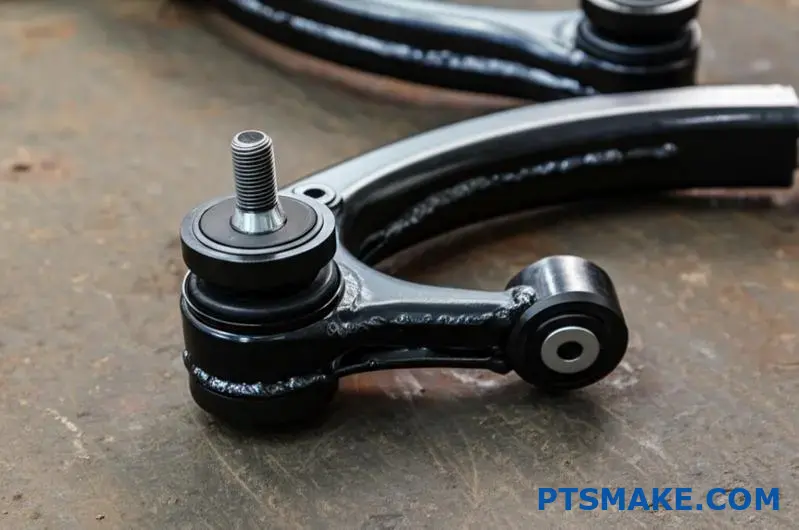
Customized Performance Characteristics
Perhaps the most valuable aspect of custom control arms is their ability to be tailored to specific performance goals. Whether you’re building a rock crawler that needs extreme articulation, a track car that demands precise handling, or a street truck that requires both durability and comfort, custom arms can be configured accordingly.
This customization extends to:
- Adjustable mounting points for fine-tuning alignment
- Variable bushing durometers for specific handling characteristics
- Specialized designs for specific vehicle modifications
- Compatibility with other aftermarket components
By upgrading to custom control arms, you’re not just replacing a part—you’re investing in a foundation that supports your vehicle’s entire performance envelope and enables further modifications. This strategic approach to vehicle building has proven invaluable for countless clients I’ve worked with who initially underestimated the importance of these critical suspension components.
Materials and Construction Technologies
Have you ever wondered why some vehicles handle rough terrain effortlessly while others falter at the first bump? The secret often lies beneath the surface – in the materials and manufacturing techniques used for critical suspension components like custom control arms.
Modern custom control arms utilize advanced materials and precision engineering to create components that outperform factory parts in virtually every metric – offering superior strength-to-weight ratios and dramatically improved performance capabilities.
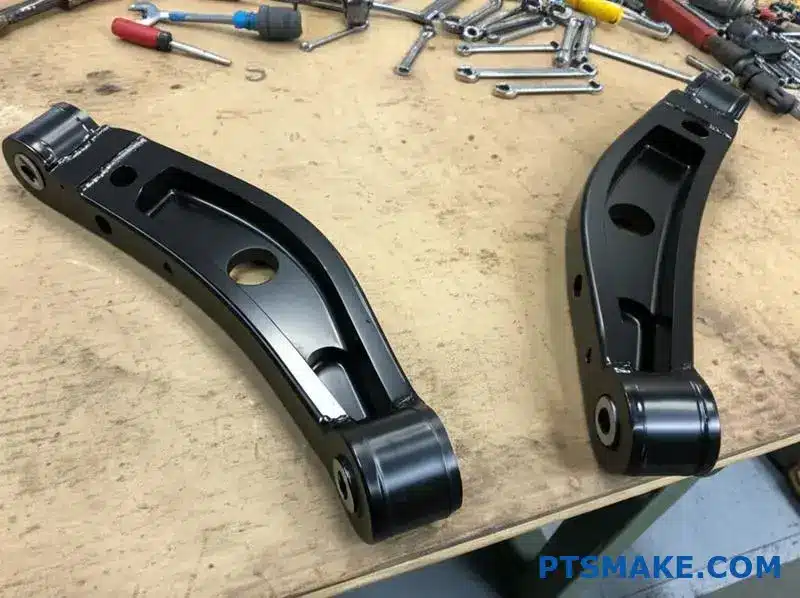
Advanced Materials Revolutionizing Control Arm Design
The evolution of custom control arms begins with material selection. While factory control arms typically utilize standard-grade steel or aluminum to meet cost constraints, aftermarket manufacturers have pushed boundaries by incorporating aerospace-grade materials that offer exceptional performance characteristics.
DOM Tubing – The Industry Standard
Drawn Over Mandrel (DOM) tubing represents one of the most significant advancements in control arm construction. This seamless steel tubing undergoes a specialized manufacturing process that:
- Eliminates weak points found in welded tubing
- Creates consistent wall thickness throughout
- Provides superior tensile strength
- Maintains structural integrity under extreme stress
DOM tubing offers approximately 20-30% greater strength compared to standard welded tubing of the same diameter, making it ideal for applications where durability is paramount. At PTSMAKE, we’ve consistently found DOM tubing to be the preferred choice for vehicles subjected to heavy off-road use or carrying significant additional weight.
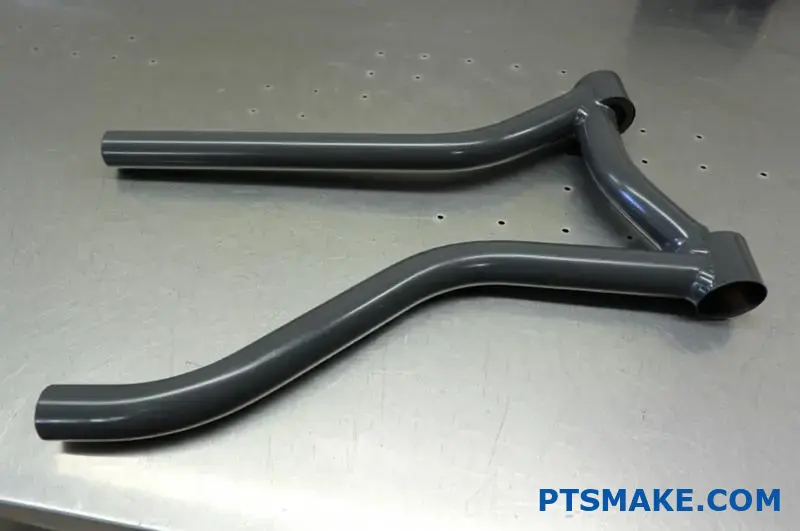
Chromoly Steel Alloys
For applications demanding the ultimate in strength and impact resistance, many premium control arms utilize chromoly steel (chromium-molybdenum alloy). This material offers:
- Up to 40% higher tensile strength than conventional steel
- Superior fatigue resistance
- Excellent impact absorption
- Better performance in extreme temperature conditions
The advantages of chromoly become particularly evident in high-stress scenarios like competition off-roading or track use. While the material costs more than standard steel, the performance benefits and extended service life typically offset the initial investment.
Billet Aluminum Components
The precision machining capabilities of modern CNC technology have made billet aluminum components increasingly common in custom control arm designs. These components offer:
- Significant weight reduction (up to 40% lighter than steel equivalents)
- Excellent corrosion resistance
- Precise tolerances and fitment
- Attractive appearance for show vehicles
The metallurgical properties2 of high-grade aluminum alloys used in control arms typically allow for thicker sections in critical areas while maintaining a weight advantage over steel components. This strategic material placement helps distribute loads more effectively than factory stamped arms.
Manufacturing Techniques That Enhance Performance
Material selection represents only half the equation in creating superior control arms. The manufacturing processes employed play an equally crucial role in determining final performance.
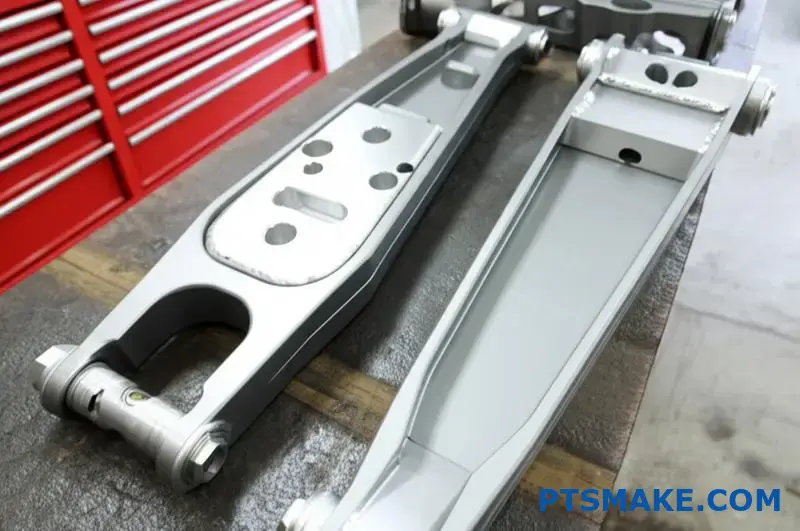
CNC Precision Machining
Computer Numerical Control (CNC) machining has revolutionized control arm production by enabling:
- Extremely tight tolerances (often within 0.001")
- Consistent quality across production runs
- Complex geometries impossible with traditional methods
- Strategic material removal for optimized strength-to-weight ratios
In my experience overseeing manufacturing at PTSMAKE, the precision afforded by multi-axis CNC machines allows us to create control arms that maintain perfect alignment specifications throughout their service life. This precision translates directly to improved vehicle handling and predictability.
Advanced Welding Techniques
The joining methods used in custom control arm construction have evolved significantly, with TIG (Tungsten Inert Gas) welding now standard for premium components. This process creates:
- Stronger joints with deeper penetration
- Reduced heat-affected zones
- More aesthetic weld beads
- Superior structural integrity
Many manufacturers, including our team at PTSMAKE, employ fixtures and jigs during the welding process to prevent warping and ensure geometric accuracy. Post-weld heat treatments further enhance structural integrity by relieving internal stresses.
Stress Analysis and Optimization
Perhaps the most significant advancement in control arm design comes from computer modeling and stress analysis. Using Finite Element Analysis (FEA) software, engineers can:
- Identify potential failure points before production
- Optimize material placement for maximum strength
- Reduce weight without compromising structural integrity
- Simulate real-world stress scenarios
This approach allows for iterative design improvements that would be impossible through traditional trial-and-error methods. The result is control arms that precisely balance strength, weight, and performance characteristics.
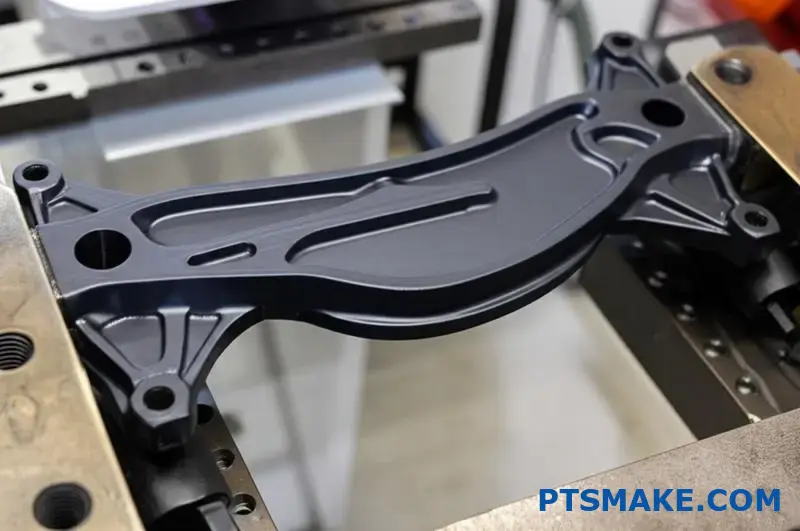
Bushing and Joint Technology
The performance of custom control arms depends heavily on their connection points. Modern bushings and joints represent significant upgrades over factory components:
Polyurethane Bushings
Unlike rubber factory bushings that prioritize noise isolation, polyurethane bushings offer:
- 200-300% longer service life
- Reduced deflection under load
- Available in multiple durometer ratings for customized performance
- Superior resistance to oils, chemicals, and environmental degradation
The ability to select specific durometer ratings allows fine-tuning between handling precision and NVH (Noise, Vibration, Harshness) characteristics.
Spherical Bearings and Rod Ends
For maximum precision, many high-performance control arms incorporate:
- Teflon-lined spherical bearings
- Heavy-duty rod ends with precision ball joints
- Zero-deflection connection points
- Adjustable mounting positions
These components eliminate the flex inherent in rubber and even polyurethane bushings, providing absolutely direct feedback and control. While they may transmit more road noise and vibration, the performance benefits make this trade-off worthwhile for serious enthusiasts.
Load Distribution Capabilities
The geometric design of custom control arms often addresses a critical limitation of factory components: uneven load distribution. Custom arms typically feature:
- Increased triangulation for better force distribution
- Strategic gusseting at high-stress areas
- Wider mounting points for improved leverage
- Optimized suspension geometry throughout travel range
These design elements ensure that forces are transferred more evenly throughout the control arm, reducing stress concentrations that can lead to failure. The difference becomes particularly noticeable when vehicles are modified with larger tires, lift kits, or additional weight.
Through thoughtful material selection and advanced manufacturing techniques, today’s custom control arms deliver performance capabilities that were once the exclusive domain of purpose-built racing vehicles. The investment in these components provides tangible benefits in durability, handling, and overall vehicle capability that simply cannot be achieved with factory parts.
Ever wondered why some off-road beasts seem to conquer impossible terrain while others struggle with basic obstacles? The secret often lies in their joint systems – those critical connection points that determine just how far your suspension can really travel.
Advanced joint systems like Jeebus Joints represent a revolutionary step beyond traditional ball joints, offering dramatically increased travel range while delivering superior service life and articulation capabilities essential for serious off-road and performance applications.
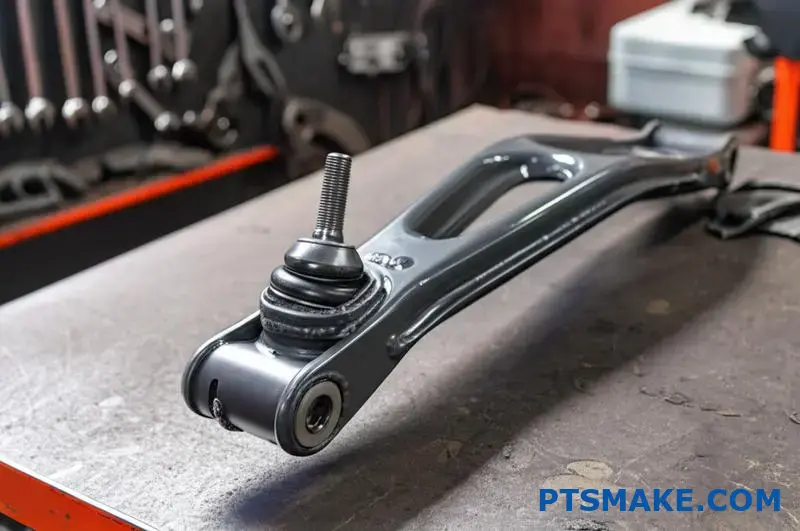
The Evolution Beyond Traditional Ball Joints
Standard ball joints have served vehicles well for decades, but they come with inherent limitations. These spherical bearings enclosed in housing allow for pivoting movement but restrict travel range and articulation. For daily drivers on paved roads, they’re perfectly adequate. However, when pushing vehicles to extremes off-road or in performance applications, these limitations become painfully apparent.
Traditional ball joints typically allow for around 30-45 degrees of travel before binding or reaching their mechanical limits. This restriction becomes a major performance bottleneck when traversing uneven terrain or during suspension compression/extension cycles in performance driving.
The Jeebus Joint Revolution
Among the most innovative alternatives to traditional ball joints is the Jeebus Joint system. This patented design fundamentally reimagines the connection point between suspension components, offering:
- Nearly double the travel range of traditional ball joints
- Significantly reduced binding under extreme articulation
- Self-lubricating properties for extended service intervals
- Greater resistance to contamination from mud, water, and debris
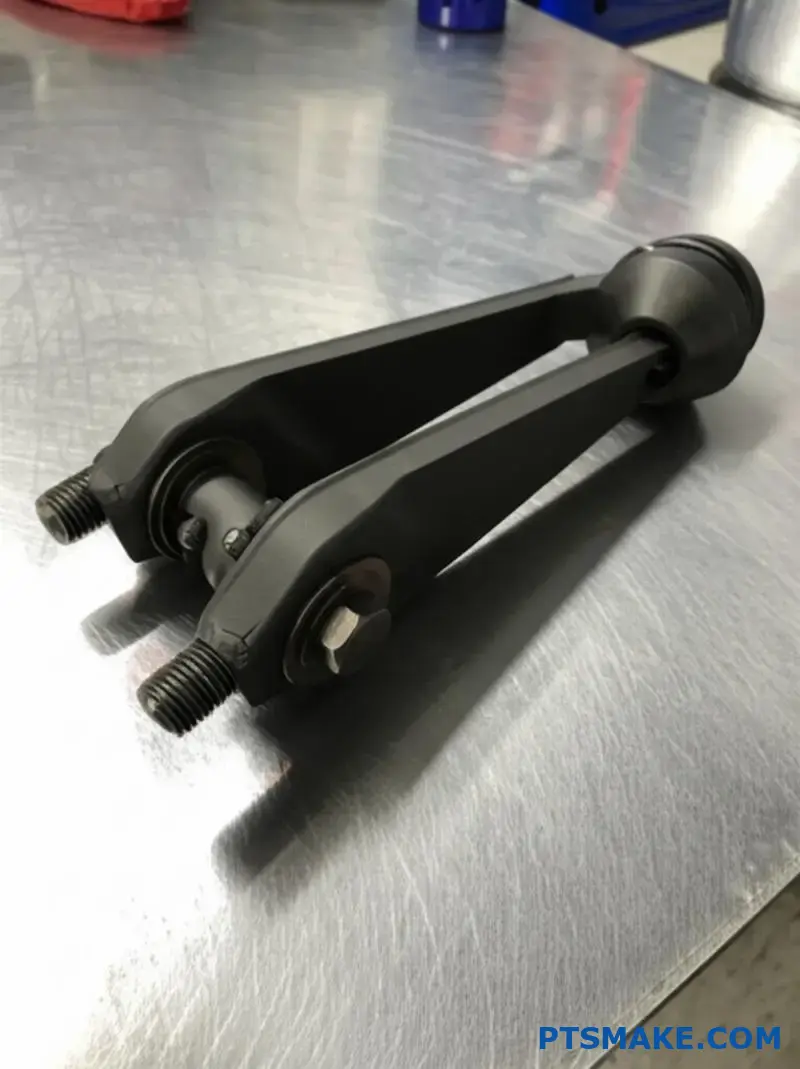
The Jeebus Joint achieves this through a clever design that replaces the traditional ball-in-socket approach with a multi-axis pivot system. This allows for movement across multiple planes simultaneously without the traditional binding points that limit conventional ball joints.
In my work at PTSMAKE, I’ve installed Jeebus Joint systems on numerous custom control arm setups, and the difference is immediately noticeable – especially in vehicles that regularly face challenging terrain or undergo substantial suspension cycling.
Other Advanced Joint Alternatives
While Jeebus Joints represent one innovative approach, several other advanced joint systems offer compelling advantages over traditional ball joints:
Rebuildable High-Angle Joints
These specialized joints feature:
- Replaceable wear components for extended service life
- Housing designs that allow for up to 60 degrees of articulation
- Heavy-duty construction with aerospace-grade materials
- Field serviceability when far from repair facilities
The ability to rebuild these joints in the field makes them particularly valuable for overlanding vehicles and expedition rigs that might be hundreds of miles from the nearest service center.
Hydro-Pneumatic Articulation Systems
At the cutting edge of suspension technology, these systems employ:
- Pressurized fluid chambers to dampen impact forces
- Expandable joint housings that adapt to articulation needs
- Integrated thermal management to maintain optimal performance
- Self-compensating wear adjustments
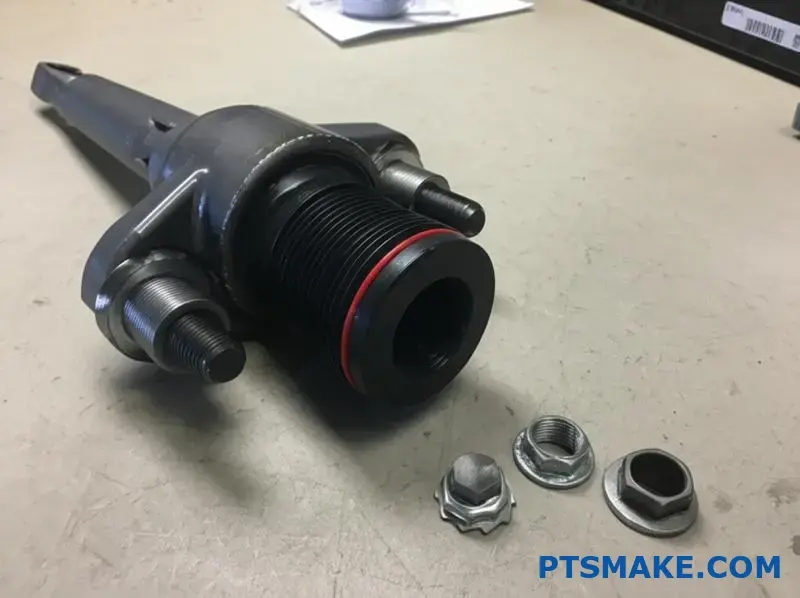
While significantly more complex and expensive than other alternatives, hydro-pneumatic systems offer unparalleled articulation combined with progressive damping characteristics that can transform a vehicle’s off-road capability.
Performance Benefits of Advanced Joint Systems
The advantages of upgrading to these specialized joint systems extend far beyond simply increasing articulation range:
Extended Service Life
Advanced joint systems typically offer 2-3 times the service life of conventional ball joints. This longevity comes from:
- More sophisticated sealing systems that prevent contamination
- Higher-grade materials that resist wear and fatigue
- Load distribution designs that reduce stress concentrations
- Better thermal management during extreme use
For custom control arms subjected to extreme use, these systems dramatically reduce maintenance intervals and overall ownership costs despite their higher initial investment.
Superior Articulation Geometry
Traditional ball joints often create binding issues when suspension components reach their extremes of travel. Advanced alternatives maintain proper articulation geometry throughout their range by:
- Eliminating the mechanical stops present in conventional designs
- Providing consistent resistance throughout the travel range
- Maintaining optimal preload tension3 as joint positions change
- Preventing sudden binding that can damage other suspension components
This consistent performance across the entire range of motion results in more predictable handling characteristics, even in extreme situations.
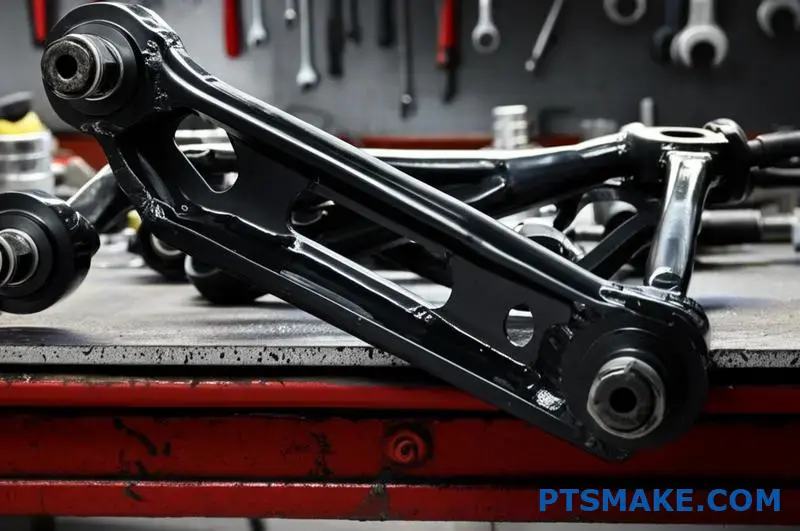
Impact Resistance
Advanced joint systems typically absorb impacts more effectively than traditional ball joints. This capability comes from:
| Feature | Traditional Ball Joints | Advanced Joint Systems |
|---|---|---|
| Maximum Impact Force | Moderate | High to Very High |
| Load Distribution | Concentrated | Broadly Distributed |
| Failure Mode | Sudden | Progressive |
| Recovery After Impact | Limited | Self-Centering |
| Impact Dampening | Minimal | Substantial |
This enhanced impact resistance proves particularly valuable when traversing rocky terrain or landing jumps, where sudden shock loads can instantly destroy conventional ball joints.
Installation Considerations
Upgrading to advanced joint systems typically requires careful planning and sometimes modification of existing components. The key considerations include:
Compatibility Issues
Most advanced joint systems don’t use the same mounting dimensions as factory ball joints. This generally requires:
- Custom control arms designed specifically for the advanced joints
- Modification of existing components (not always recommended)
- Potential changes to other suspension components
- Recalibration of alignment specifications
At PTSMAKE, we typically recommend complete control arm replacement rather than attempting to adapt advanced joints to factory arms, as the latter approach often compromises the performance benefits these systems can provide.
Maintenance Requirements
While advanced joint systems generally offer longer service intervals, they often have different maintenance requirements:
- Some require periodic greasing with specialized lubricants
- Others feature sealed designs that need no maintenance but cannot be serviced
- Certain systems have wear indicators that should be checked regularly
- Many have torque specifications that differ substantially from conventional joints
Understanding these maintenance requirements is essential for maximizing the service life of these specialized components.
Cost-Benefit Analysis
Advanced joint systems represent a significant investment compared to standard ball joints. When evaluating their value, consider:
- The typical usage pattern of the vehicle
- The cost of repeated replacement of conventional joints
- The performance limitations imposed by standard joints
- The potential damage to other components caused by binding
For casual off-roaders or street performance applications with minimal suspension travel needs, the investment may be difficult to justify. However, for serious enthusiasts pushing their vehicles to extremes, advanced joint systems often represent one of the most cost-effective upgrades available when considering long-term performance and reliability.
Through my experience working with various suspension systems at PTSMAKE, I’ve found that vehicles equipped with advanced joint systems consistently outperform those with conventional ball joints when subjected to demanding conditions. The investment pays dividends not just in capability, but in reduced maintenance costs and extended component life throughout the suspension system.
<
Vehicle-Specific Custom Control Arm Solutions
Ever wondered why your classic Mustang doesn’t corner like its modern counterpart, or why your lifted Jeep feels unstable at highway speeds? The secret lies in vehicle-specific suspension geometry – a critical factor that generic control arms simply can’t address properly.
Custom control arms designed specifically for your vehicle’s make and model deliver transformative performance by addressing the unique suspension characteristics inherent to your platform, whether it’s a 1960s muscle car or the latest performance SUV.
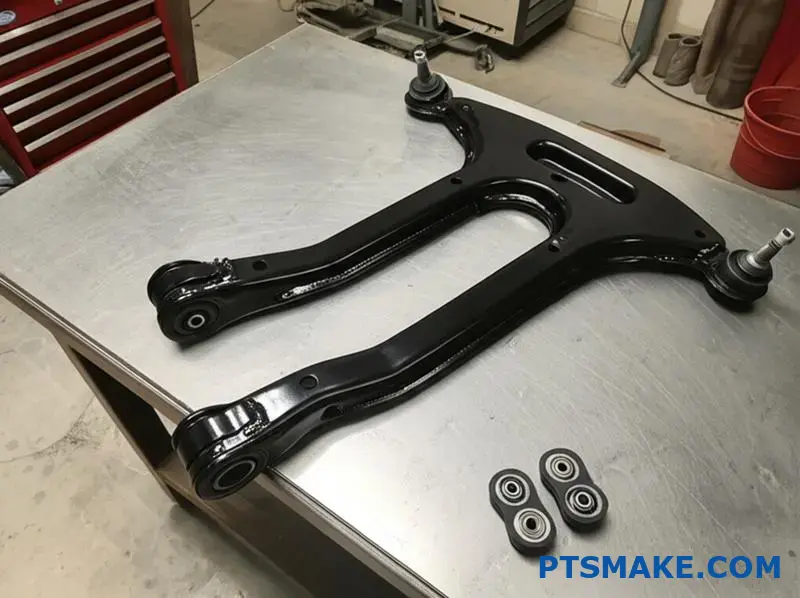
Matching Control Arms to Vehicle Design Philosophy
Each vehicle platform comes with its own suspension design philosophy that reflects its intended purpose. Sports cars prioritize handling precision, luxury vehicles emphasize comfort, and off-road vehicles focus on articulation and durability. These fundamental design differences mean that control arm upgrades must be tailored to complement the vehicle’s inherent character.
Performance Vehicle Applications
Sports and performance cars typically employ suspension geometries that prioritize handling response and stability at speed. When upgrading these vehicles, custom control arms should:
- Maintain or improve camber curves during compression
- Provide increased caster for better straight-line stability
- Reduce compliance and deflection under high cornering loads
- Complement factory anti-dive and anti-squat characteristics
For example, a platform-specific solution for a BMW E46 M3 would address the model’s known weaknesses like rear subframe mounting points while preserving the precision handling that makes these vehicles legendary.
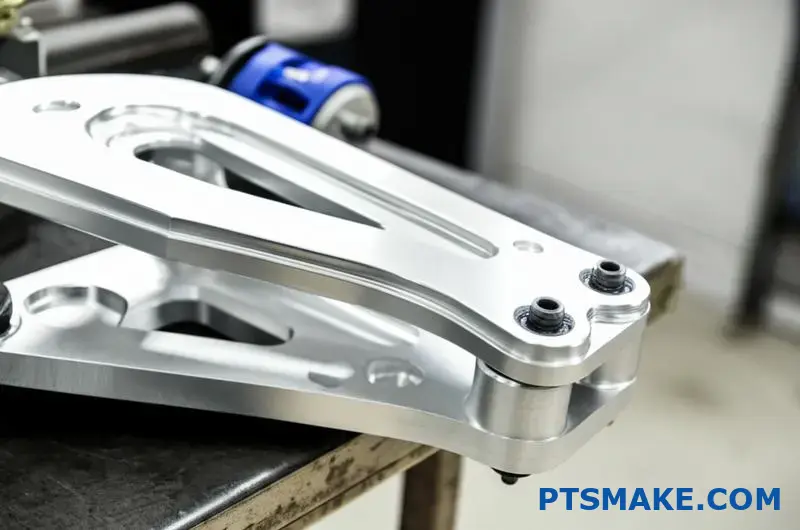
Classic Car Restoration and Upgrades
Vintage vehicles present unique challenges when upgrading suspension components. Many classic cars utilized primitive suspension designs with inherent limitations:
- Excessive body roll due to soft springs and minimal anti-roll equipment
- Imprecise steering from vague linkages and excessive compliance
- Poor camber control through suspension travel
- Limited ability to handle modern tire compounds and widths
Custom control arms for classic vehicles must address these issues while respecting the vehicle’s character. At PTSMAKE, we’ve developed systems for popular classics that retain period-correct appearance while incorporating modern engineering principles. These solutions typically involve:
- Revised geometry to improve camber control
- Stronger materials to reduce flex
- Modern bushing compounds that maintain a comfortable ride
- Bolt-in installation that requires no permanent modification
The improvement in handling, stability, and safety can be transformative, bringing vintage driving dynamics closer to modern standards without sacrificing the classic feel that enthusiasts cherish.
Off-Road Vehicle Optimization
Off-road vehicles face perhaps the most demanding conditions of any automotive application, requiring control arms that can withstand extreme articulation and impact loads. Platform-specific designs here are critical because:
- Each 4×4 model has unique suspension mounting points
- Wheelbase and track width affect optimal arm length
- Factory departure and approach angles must be preserved or improved
- Different vehicles have vastly different weight distributions
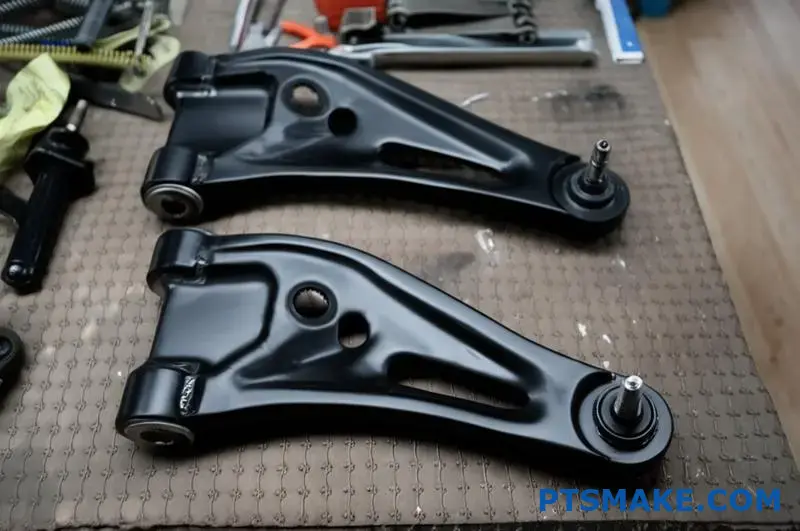
Jeep Platform Solutions
Jeep vehicles represent the most commonly modified off-road platforms, with each generation offering different challenges:
| Jeep Model | Common Issues | Custom Arm Solutions |
|---|---|---|
| Wrangler JK/JL | Bump steer with lifts | Corrected geometry arms with drop brackets |
| Cherokee XJ | Control arm mount fatigue | Reinforced mounting points and stronger arms |
| Grand Cherokee WJ | Limited articulation | Long-travel arms with high-angle joints |
| Gladiator JT | Rear axle hop under load | Extended control arms with optimized damping |
The right control arm solution for a Jeep Wrangler with 35-inch tires will be dramatically different from what works on a Grand Cherokee, even though both share similar off-road ambitions.
Truck and SUV Applications
Full-size trucks and SUVs require control arms that address their substantial weight and towing capabilities:
- Heavier-duty bushings that can handle increased mass
- Stronger materials to resist bending under load
- Optimized geometry for stability with variable loading conditions
- Compatibility with factory electronic systems like stability control
When designing control arms for platforms like the Ford F-150 or Chevrolet Tahoe, we account for not just the vehicle’s stock weight but also common modifications and usage patterns. This might include accommodating winch bumpers that add front-end weight or leveling kits that alter ride height.
Modern Performance Car Solutions
Today’s performance vehicles increasingly utilize multi-link suspension designs that rely on multiple control arms working in concert. These sophisticated systems require equally sophisticated upgrade solutions:
- Precisely maintained geometry to preserve factory kinematic behavior4
- Compatibility with electronic adaptive damping systems
- Materials that reduce unsprung weight for better response
- Design that complements other performance modifications
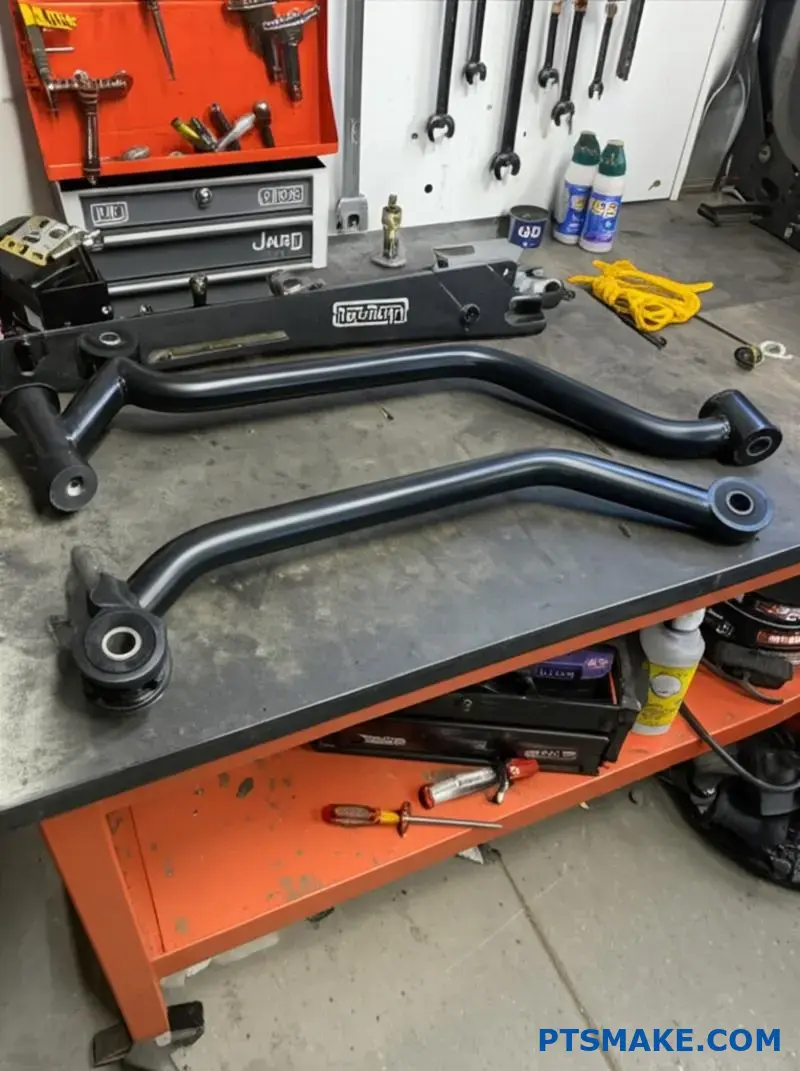
European Sport Sedan Applications
German and other European performance sedans typically employ complex multi-link designs that present unique challenges when upgrading. For platforms like Mercedes-Benz AMG models or Audi S/RS vehicles, control arm upgrades must:
- Maintain factory electronic suspension calibration compatibility
- Provide increased rigidity without excessive NVH transfer
- Address model-specific weak points (such as ball joint failures)
- Complement factory active alignment systems
These applications often benefit from adjustable control arms that allow fine-tuning of alignment specifications beyond factory ranges, enabling owners to optimize for track use while maintaining street drivability.
Japanese Performance Platforms
Japanese sports cars and performance sedans like the Nissan 370Z, Subaru WRX STI, or Honda Civic Type R each come with their own suspension philosophies and challenges:
- The Nissan Z platform benefits from front upper control arms that increase caster
- Subaru’s rally-inspired designs often need rear arms that improve camber control
- Honda’s front-wheel-drive platforms typically benefit from improved rear geometry for better stability
Each platform requires specific engineering solutions that address its unique characteristics and common modifications. A one-size-fits-all approach simply doesn’t work when optimizing performance.
Addressing Platform-Specific Weaknesses
Beyond general performance enhancement, many vehicle platforms have known suspension weaknesses that custom control arms can specifically address:
BMW E36/E46 Rear Trailing Arm Bushings
BMW’s E36 and E46 3-Series models are notorious for rear trailing arm bushing failure that can lead to unpredictable handling. Custom control arms with reinforced mounting points and polyurethane or solid bushings eliminate this weakness while improving overall handling precision.
Ford Mustang Front Geometry
Fox-body through S197 Mustangs benefit enormously from revised front control arms that address the platform’s inherent limitations. Custom solutions typically provide:
- Improved roll center height for better weight transfer
- Reduced bump steer for more predictable handling
- Better camber control during suspension compression
- Increased caster for enhanced stability and steering feel
Toyota Tacoma/4Runner IFS Control Arm Limitations
Toyota’s independent front suspension (IFS) used in Tacoma trucks and 4Runner SUVs presents challenges when lifted. Platform-specific upper control arms can:
- Restore proper ball joint angles for reduced wear
- Improve wheel travel for better off-road performance
- Correct camber curves for better tire wear
- Enhance overall durability for off-road use
Installation and Compatibility Considerations
Vehicle-specific control arms should be designed for straightforward installation without requiring extensive modification. Key considerations include:
- Direct bolt-in fitment using factory mounting points
- Maintaining compatibility with factory or popular aftermarket components
- Preserving attachment points for brake lines, ABS sensors, and other accessories
- Including comprehensive instructions specific to the vehicle platform
When designing control arms at PTSMAKE, we thoroughly test each application on the specific vehicle platform to ensure proper fitment and performance. This attention to detail eliminates the trial-and-error process often associated with generic control arm solutions.
In my experience, the difference between generic control arms and those designed specifically for a particular vehicle is immediately apparent. The vehicle-specific solution feels more integrated, performs more predictably, and generally delivers a more cohesive driving experience that complements the vehicle’s inherent character rather than fighting against it.
Performance Gains in Handling and Stability
Want to transform your vehicle from mild to wild? The secret isn’t always under the hood – it’s often hiding in your suspension system. Custom control arms can deliver the kind of handling precision and stability that separates extraordinary rides from ordinary ones.
Custom control arms represent one of the most significant suspension upgrades available, delivering dramatic improvements in cornering capability, steering response, and overall vehicle stability by optimizing suspension geometry and virtually eliminating flex under load.

The Physics Behind Improved Handling
Custom control arms fundamentally change how your vehicle responds to driver inputs and road conditions. While factory control arms are designed with compromises to meet cost targets and provide acceptable performance across a wide range of conditions, custom arms are engineered specifically to optimize handling dynamics.
Reduced Flex and Deflection
One of the most immediate benefits of upgrading to custom control arms is the dramatic reduction in component flex. Factory arms, particularly stamped steel designs, can flex significantly under load, which creates several handling issues:
- Unpredictable steering response during hard cornering
- Inconsistent tire contact patch under acceleration and braking
- Delayed weight transfer during direction changes
- Compromised alignment settings under load
Custom arms constructed from materials like chromoly steel, DOM (Drawn Over Mandrel) tubing, or billet aluminum provide substantially greater rigidity. This increased stiffness ensures that when you turn the steering wheel, the suspension responds immediately and predictably rather than flexing before transferring input to the wheels.
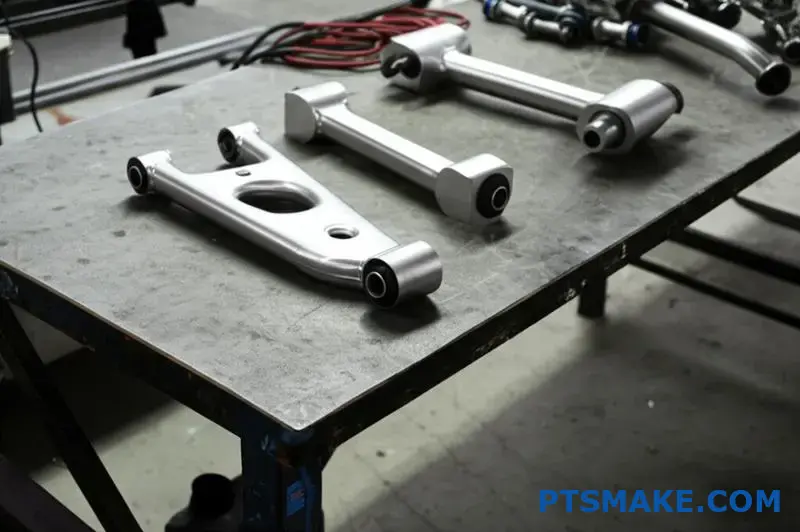
Optimized Suspension Geometry
Perhaps the most significant performance advantage comes from the ability to optimize suspension geometry for specific handling characteristics. Factory control arms must accommodate a wide range of driving conditions and user preferences, resulting in compromise designs that don’t excel in any particular area.
Custom control arms allow for precise tuning of critical suspension parameters:
| Parameter | Impact on Handling | Custom Arm Advantage |
|---|---|---|
| Camber | Affects tire contact patch during cornering | Maintains optimal tire contact throughout suspension travel |
| Caster | Influences steering feel and straight-line stability | Can be increased for better high-speed stability |
| Roll Center | Affects body roll and weight transfer | Can be optimized to reduce body roll without harsh ride quality |
| Instant Center | Determines anti-squat and anti-dive characteristics | Can be tuned for improved acceleration and braking stability |
By precisely controlling these geometric factors, custom control arms create a suspension system that responds more predictably and effectively to driver inputs and road conditions.
Enhanced Cornering Performance
The improvements in suspension geometry and component rigidity translate directly to real-world cornering performance gains. Vehicles equipped with custom control arms typically demonstrate:
Improved Turn-in Response
The initial phase of cornering, when the driver first applies steering input, is dramatically enhanced with custom control arms. The reduced compliance and optimized geometry create an immediate and linear response to steering inputs.
In my experience working with performance vehicles at PTSMAKE, this improvement is often the first thing drivers notice after installation. The steering feels more connected and responsive, with less delay between input and vehicle reaction.
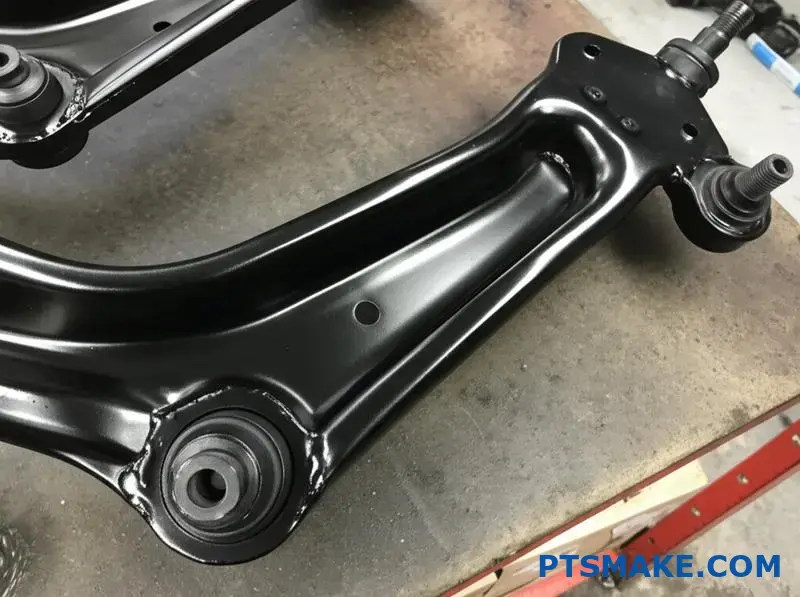
Increased Mid-Corner Stability
As the vehicle reaches the apex of a turn and maximum lateral loads are applied, custom control arms truly shine by:
- Maintaining proper camber angles throughout suspension compression
- Preventing alignment changes due to component flex
- Ensuring consistent tire contact patch for maximum grip
- Reducing understeer commonly found with factory suspension
This translates to higher cornering speeds, greater driver confidence, and the ability to carry more speed through corners without unsettling the vehicle.
Enhanced Corner Exit Traction
The final phase of cornering, where power is applied while unwinding the steering, benefits significantly from custom control arms. The improved geometry helps manage weight transfer during this critical transition, allowing for earlier and more aggressive throttle application without compromising stability.
For rear-wheel drive vehicles, this means reduced oversteer tendencies during power application. For front-wheel drive vehicles, it typically manifests as reduced torque steer and improved traction when accelerating out of corners.
Superior Stability Under Varying Conditions
Beyond pure cornering performance, custom control arms deliver substantial stability improvements across various driving conditions:
High-Speed Stability
At highway speeds and beyond, the precision of custom control arms becomes increasingly apparent. The enhanced caster settings and reduced compliance result in:
- More confident straight-line tracking
- Reduced steering corrections on uneven surfaces
- Better crosswind stability
- More predictable behavior during emergency maneuvers
This stability advantage is particularly valuable for vehicles that see track use or those that have been modified with increased power outputs, where factory suspension components may be inadequate for the vehicle’s enhanced performance envelope.
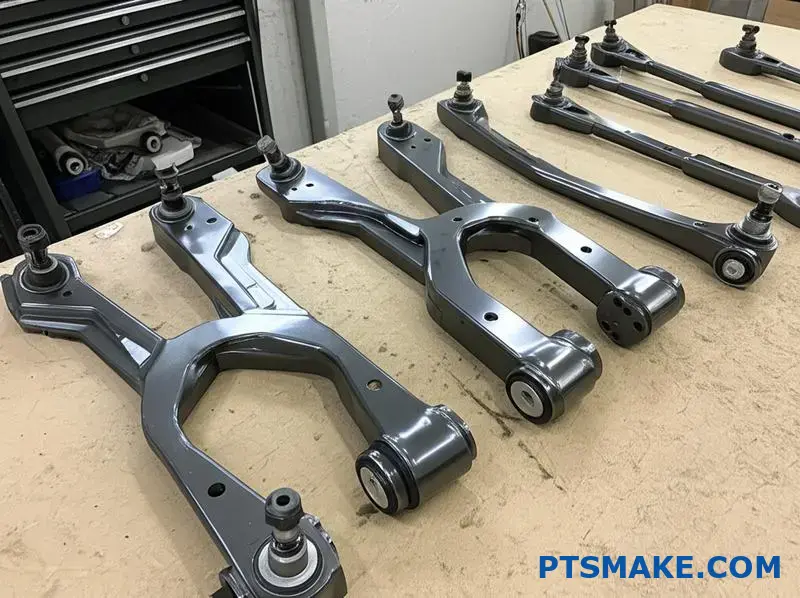
Braking Performance
Braking stability is another area where custom control arms deliver significant benefits. By controlling suspension geometry during forward weight transfer, they help maintain optimal tire contact under heavy braking. This translates to:
- Shorter stopping distances
- More consistent braking performance
- Reduced nose dive during emergency stops
- Improved stability during threshold braking
For vehicles used in competition or performance driving events, this braking advantage can be as valuable as improvements in cornering or acceleration.
Load Management
Many vehicles experience dramatic changes in handling characteristics when loaded with passengers or cargo. Custom control arms, particularly those with stiffer bushings or adjustable geometry, help maintain consistent handling regardless of loading conditions.
This becomes especially important for:
- Performance SUVs and crossovers
- Sports cars used for grand touring
- Vehicles that tow occasionally
- Daily drivers that see varying passenger loads
Real-World Performance Translation
The technical benefits of custom control arms translate to measurable real-world performance improvements:
- Lap times at track events typically drop by 1-3% immediately after installation
- Slalom and autocross times show similar improvements
- Emergency lane-change maneuvers can be executed with greater control and confidence
- Driver fatigue during spirited driving is reduced due to more predictable vehicle responses
In my 15+ years working with performance suspensions, I’ve consistently found that custom control arms deliver some of the highest returns on investment of any handling upgrade. While they may not have the visual impact of larger wheels or the auditory drama of an exhaust system, the performance gains they deliver fundamentally transform how a vehicle drives and responds.
It’s worth noting that these performance benefits come with minimal downsides when properly engineered components are selected. Unlike some handling modifications that significantly compromise ride quality or NVH (Noise, Vibration, Harshness) characteristics, quality custom control arms can deliver substantial performance improvements while maintaining reasonable comfort for daily driving – truly offering the best of both worlds for the discerning enthusiast.
Professional Installation vs. DIY Considerations
Have you ever been faced with that pivotal decision – tackle a suspension upgrade yourself or trust a professional with your vehicle’s handling and safety? It’s a crossroads every enthusiast encounters, especially when dealing with complex components like custom control arms.
When upgrading to custom control arms, the installation method you choose can significantly impact both performance outcomes and long-term reliability, with professional installation offering precision alignment and expertise while DIY approaches provide cost savings and personal satisfaction.
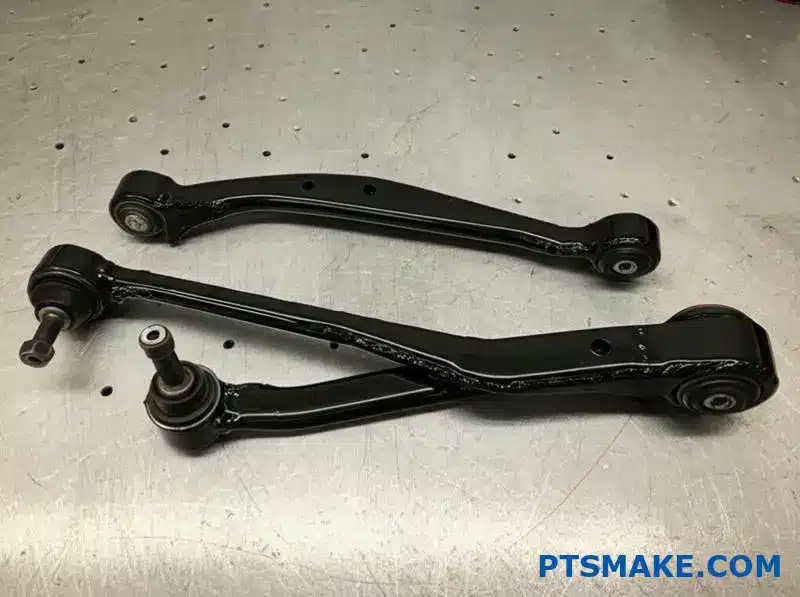
Understanding the Installation Challenge
Custom control arms represent one of the most impactful suspension upgrades available, but their installation involves far more complexity than simply swapping parts. These components directly influence your vehicle’s suspension geometry, which affects everything from handling and tire wear to overall safety.
Professional Installation Benefits
Having professionally installed hundreds of custom control arm sets at PTSMAKE, I’ve observed several distinct advantages to letting experts handle this critical upgrade:
Precision Alignment Capability
Professional shops have access to:
- Computerized alignment equipment with accuracy to 0.01 degrees
- Real-time adjustment feedback systems
- Vehicle-specific alignment specifications
- The expertise to optimize alignment for your specific usage
This precision ensures your new control arms deliver maximum performance and longevity. Even slight misalignments can dramatically accelerate tire wear and compromise handling characteristics.
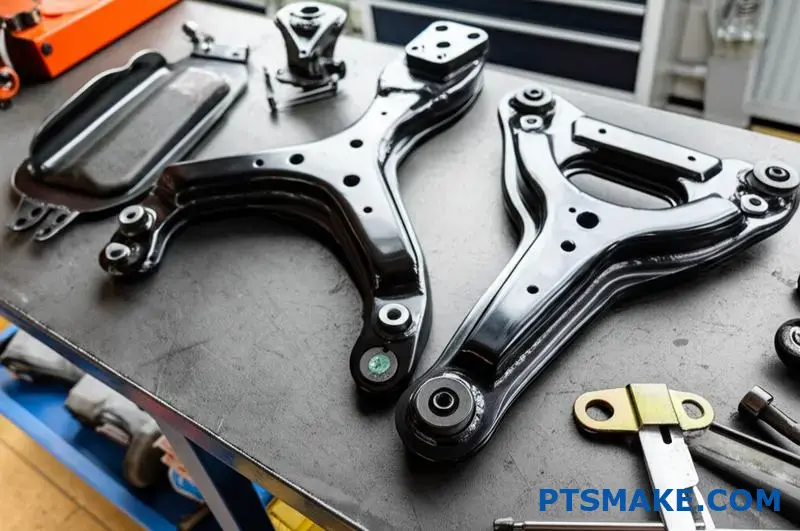
Specialized Tools and Equipment
Professional installations benefit from:
| Tool/Equipment | Purpose | DIY Alternative |
|---|---|---|
| Spring compressors | Safely disassemble strut assemblies | Rental options (with safety concerns) |
| Ball joint press | Remove/install ball joints without damage | Makeshift solutions often damage components |
| Torque wrenches | Ensure proper fastener tension | Available but costly for quality units |
| Alignment rack | Precise suspension adjustment | Not feasible for home use |
| Specialty sockets | Access OEM fasteners without damage | Often unavailable to consumers |
Many of these specialized tools represent significant investments that are difficult to justify for a one-time project.
Professional Experience and Knowledge
Perhaps the most valuable aspect of professional installation is the experience that comes from performing similar jobs repeatedly:
- Recognition of vehicle-specific quirks and challenges
- Ability to spot worn components that should be replaced simultaneously
- Knowledge of proper torque sequences and specifications
- Understanding of bushing preload requirements
- Familiarity with common pitfalls and their solutions
This experience often means the difference between a straightforward installation and hours of frustrating troubleshooting.
DIY Installation Considerations
Despite the advantages of professional installation, many enthusiasts prefer the DIY approach for valid reasons:
Cost Savings
The most obvious benefit is financial – professional installation typically adds 15-30% to the total project cost. For enthusiasts on a budget, this saving can be significant, especially when factoring in:
- Labor rates at performance shops ($90-150/hour in most markets)
- Alignment fees ($80-150 for performance alignment)
- Potential diagnostic time if complications arise
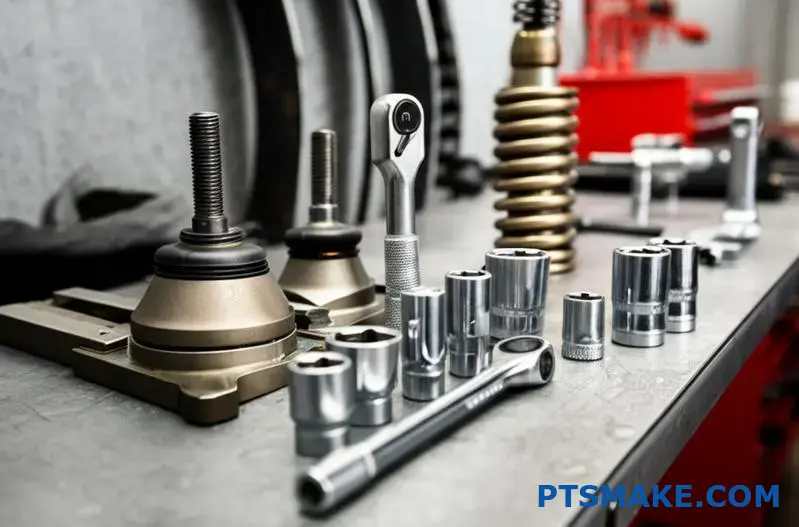
Learning Opportunity
For many enthusiasts, the knowledge gained during a challenging installation represents value beyond the monetary savings:
- Deeper understanding of suspension dynamics
- Greater familiarity with your specific vehicle
- Improved ability to diagnose future issues
- Skills that transfer to other maintenance tasks
This educational aspect shouldn’t be underestimated, as it builds confidence and competence for future projects.
Personal Satisfaction
There’s undeniable pride in completing a technical installation yourself. Many of my customers who choose the DIY route express tremendous satisfaction in:
- Overcoming technical challenges
- Directly experiencing the "before and after" transformation
- Knowing exactly how every component was installed
- The ability to tell others "I did that myself"
This satisfaction factor is entirely legitimate and represents real value for many enthusiasts.
Making the Right Decision for Your Situation
The optimal choice between professional installation and DIY approaches depends on several factors unique to your situation:
Technical Capability Assessment
Be honest about your mechanical abilities and experience. Consider:
- Have you successfully completed similar suspension projects?
- Do you understand alignment principles and their impact?
- Can you properly interpret installation instructions?
- Are you comfortable with potential complications?
Even experienced DIYers sometimes reach their limits with suspension geometry adjustments, which require both specialized knowledge and equipment.

Project Complexity Factors
Not all custom control arm installations present equal difficulty:
Vehicle-Specific Challenges
Some vehicles present particular installation challenges:
- European luxury vehicles often have complex electronic systems that require recalibration
- Certain 4×4 platforms require careful adjustment of multiple control arms simultaneously
- Sports cars with multi-link suspensions may require special procedures to maintain factory geometry
Installation Type Complexity
The installation difficulty varies considerably depending on:
| Installation Type | Complexity Level | Professional Recommendation |
|---|---|---|
| Simple bolt-on rear arms | Low to Moderate | DIY feasible with basic tools |
| Front control arms with ball joints | Moderate to High | Professional preferred |
| Adjustable control arms requiring alignment | High | Professional strongly recommended |
| Systems with electronic suspension components | Very High | Professional essential |
Tool Availability and Workspace Considerations
Successful DIY installation requires:
- Sufficient workspace with good lighting
- Jack stands or a lift for safe access
- Complete tool set including specialty items
- Alignment capability or budget for post-installation alignment
Without these essentials, even straightforward installations can become frustrating or potentially dangerous.
The Hybrid Approach: A Practical Compromise
Many of my customers at PTSMAKE opt for a middle-ground solution that offers advantages of both approaches:
- DIY installation of the control arms themselves
- Professional alignment and final adjustment
This hybrid approach allows enthusiasts to experience the hands-on satisfaction of the installation while ensuring the precision of professional alignment. It typically saves about half the labor cost while greatly reducing the risk of alignment-related issues.
For adjustable control arms in particular, this approach makes tremendous sense, as it leverages your mechanical ability for the straightforward removal and installation while utilizing professional expertise for the critical geometry adjustments.
Safety Considerations and Risk Assessment
Safety should remain paramount regardless of which installation path you choose:
- Suspension components directly affect vehicle control and stability
- Improper installation can lead to unpredictable handling
- Component failure due to installation errors can be catastrophic
- Alignment specifications exist for specific safety reasons
If you choose the DIY route, always follow manufacturer instructions precisely, use proper torque specifications, and never skip the professional alignment step – even if the vehicle "seems to drive straight" after installation.
In my years of experience, I’ve seen the outstanding results that come from properly installed custom control arms. Whether you choose professional installation, DIY, or a hybrid approach, the performance benefits will be substantial when the job is done correctly. The key is making an informed decision based on your specific circumstances, capabilities, and goals.
Customization Options and Design Features
Ever wondered why some vehicles seem to float effortlessly over rough terrain while others bounce and jolt at the slightest imperfection? The secret often lies in one critical component: custom control arms that can transform how your suspension performs in virtually any driving situation.
Custom control arms offer unprecedented personalization through adjustable geometry settings, specialized bushing materials, and coilover compatibility, allowing enthusiasts to fine-tune their suspension characteristics for specific driving applications from daily commuting to competitive motorsports.
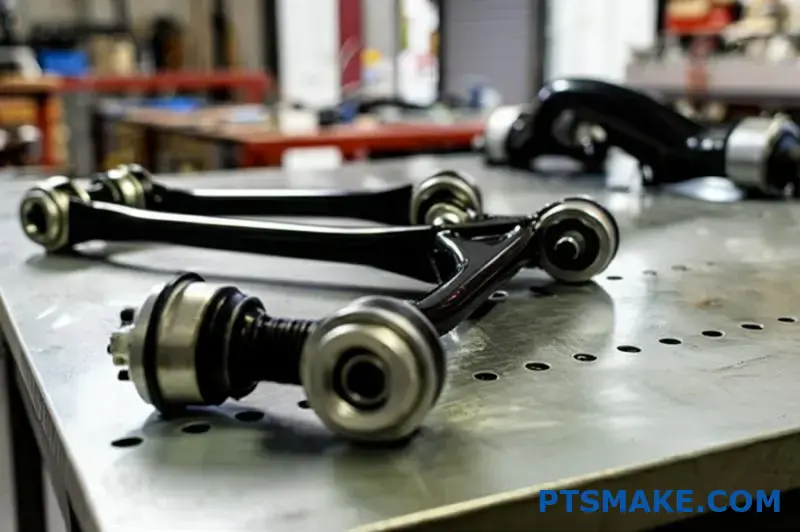
The Evolution of Adjustable Control Arms
The days of one-size-fits-all suspension components are long behind us. Modern custom control arms feature a range of adjustment capabilities that allow precise tuning of your vehicle’s suspension geometry. These adjustments can transform handling characteristics, optimize performance for specific applications, and compensate for other modifications.
Caster and Camber Adjustment Options
Among the most valuable adjustment features in custom control arms are those affecting wheel alignment angles:
Camber Adjustment
Camber refers to the vertical tilt of your wheels when viewed from the front or rear of the vehicle. Custom control arms typically offer camber adjustment through:
- Eccentric bolts that rotate to change arm positioning
- Slotted mounting brackets allowing lateral movement
- Threaded adjustment rods with precision locknuts
- Cam bolts with multiple mounting positions

The ability to fine-tune camber is particularly valuable when:
- Lowering a vehicle (which often induces negative camber)
- Increasing cornering performance (slight negative camber improves grip)
- Compensating for heavy loads (which can create positive camber)
- Correcting uneven tire wear patterns
For track-focused applications, the ability to quickly adjust camber between street driving and track sessions without a complete alignment represents a significant advantage.
Caster Adjustment
Caster angle affects steering feel, stability, and return-to-center characteristics. Premium custom control arms offer caster adjustment through:
- Offset mounting bushings
- Adjustable control arm length
- Specialized caster plates
- Multi-position mounting points
Optimizing caster can dramatically improve high-speed stability and steering feedback, especially in vehicles modified for performance driving. In off-road applications, increased caster can help maintain directional stability when traversing uneven terrain.
Length Adjustability for Optimized Wheelbase
Beyond alignment angles, many custom control arms offer overall length adjustment, which provides several benefits:
- Correction of wheelbase changes from lift kits
- Centering axles in wheel wells for improved appearance
- Optimization of suspension travel and articulation
- Reduction of driveline vibrations by correcting pinion angles
This adjustability is particularly valuable for off-road vehicles where suspension modifications often create geometry issues that length-adjustable control arms can remedy.
Specialized Bushing Materials and Design
The connection points between control arms and the vehicle’s chassis or subframes play a critical role in how suspension forces are transmitted. Custom control arms offer various bushing options to tailor these characteristics precisely.
Polyurethane Bushings
These synthetic bushings represent a middle ground between rubber and solid mounts:
| Characteristic | Performance Impact |
|---|---|
| Durometer Options | Available in 65A-95A hardness ratings for tuned performance |
| Deflection Control | 60-80% less deflection than factory rubber |
| Temperature Stability | Maintains consistent performance from -40°F to 200°F |
| Chemical Resistance | Unaffected by most oils and road contaminants |
| Longevity | Typically 2-3× longer service life than rubber |
Polyurethane bushings are ideal for performance street vehicles and dual-purpose builds, offering improved precision without excessive NVH (Noise, Vibration, Harshness).
Delrin and PTFE Composite Bushings
For applications demanding maximum precision with acceptable NVH levels:
- Self-lubricating properties for smooth articulation
- Near-zero deflection under load
- Excellent wear resistance in severe conditions
- Temperature stability exceeding most driving environments
- Lighter weight than metal bushings
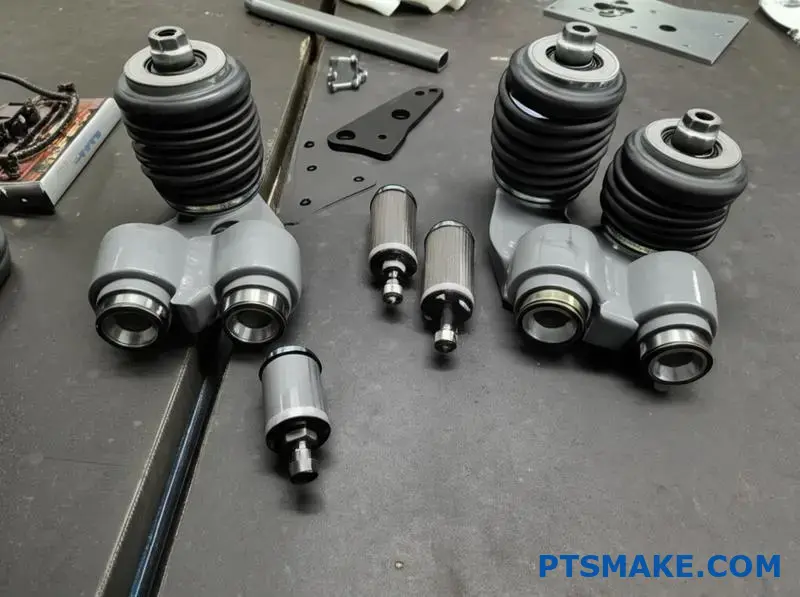
Spherical Bearings and Rod Ends
At the extreme performance end of the spectrum, many custom control arms utilize:
- Teflon-lined spherical bearings for reduced friction
- Heat-treated alloy steel races for durability
- Precision machined housings to maintain tight tolerances
- Adjustable preload to eliminate play without binding
While these connections transmit more road noise and vibration, they provide uncompromising precision for competitive driving applications where every fraction of a second matters.
Coilover and Shock Compatibility
Custom control arms are frequently designed to complement other suspension upgrades, particularly adjustable coilover systems and performance shocks.
Extended Stroke Accommodation
Quality custom control arms provide clearance for:
- Increased shock travel from lift kits
- Larger diameter shocks with remote reservoirs
- Bypassed shock absorbers for off-road applications
- Custom valving arrangements for specialized tuning
This compatibility ensures that your suspension components work together harmoniously rather than fighting each other.
Optimized Motion Ratios
The relationship between wheel movement and shock compression (motion ratio) significantly impacts suspension performance. Advanced custom control arms are designed to:
- Maintain ideal motion ratios throughout travel
- Provide progressive resistance to compression
- Eliminate binding at extreme articulation angles
- Prevent shock bottoming under heavy loads
By carefully engineering these motion characteristics, custom control arms ensure that your expensive coilovers or shocks perform as intended.
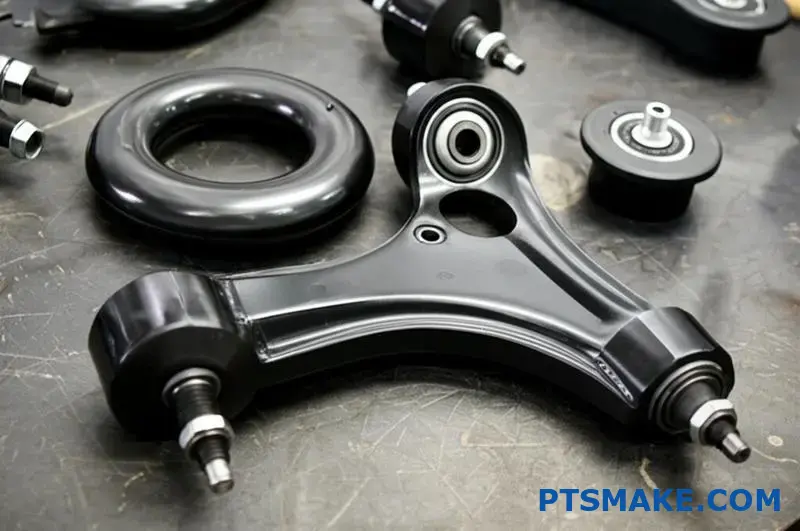
Application-Specific Design Features
Perhaps the most valuable aspect of custom control arms is their ability to address specific driving scenarios with tailored design features.
Off-Road Focused Features
For vehicles tackling challenging terrain:
- Additional skid protection for vulnerable components
- High-clearance designs that eliminate hang-up points
- Reinforced mounting points for extreme articulation
- Quick-disconnect options for maximum flex in rock crawling
Track Day Optimizations
For performance driving enthusiasts:
- Weight reduction in non-critical areas
- Adjustable roll center height capabilities
- Ackerman compensation for improved turn-in
- Anti-dive geometry modifications for better braking stability
Daily Driver Considerations
For vehicles that still need to function in everyday conditions:
- Greasable fittings for extended service intervals
- Noise-isolating bushing designs
- Corrosion-resistant finishes for all-weather durability
- OEM-compatible mounting points for straightforward installation
In my experience at PTSMAKE, the most successful custom control arm installations are those where the components were specifically chosen to match the customer’s driving priorities. A rock crawler needs fundamentally different control arm characteristics than a track car, even though both benefit from improved articulation and durability over stock components.
The beauty of modern custom control arms lies in this unprecedented level of personalization. Whether you’re building a purpose-specific competition vehicle or simply enhancing your daily driver, today’s control arm options allow you to optimize for your exact needs rather than accepting the compromises inherent in factory components.
Click here to learn how suspension geometry affects your vehicle’s performance. ↩
Learn more about how material science impacts mechanical performance in automotive applications. ↩
Learn how proper preload tension affects joint durability and performance in extreme conditions. ↩
Click to understand how suspension movement patterns affect handling, traction, and overall vehicle dynamics. ↩


